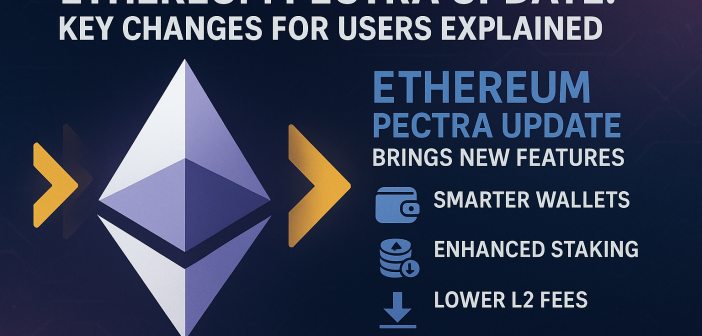The Ethereum Pectra update transforms how users interact with the network, introducing features that simplify DeFi, staking, and scaling for a better blockchain experience.
Ethereum Pectra Update Brings New Features
The Ethereum Pectra update, activated on May 7, 2025, marks the network’s biggest change since its Proof-of-Stake transition. This upgrade introduces 11 Ethereum Improvement Proposals (EIPs), enhancing user experience, staking, and Layer-2 (L2) performance. Tested in Holesky, Sepolia, and Hoodi testnets, it aims to make Ethereum more efficient and user-friendly while setting the stage for future upgrades. Key improvements include smarter wallets via account abstraction, better staking efficiency, lower L2 fees, and stronger validator operations, all boosting the broader Ethereum ecosystem.
Smarter Wallets with Account Abstraction (EIP-7702)
The Ethereum Pectra update brings account abstraction via EIP-7702, letting wallets like MetaMask function as smart contracts. Users can now pay fees in tokens like USDT instead of ETH, simplifying DeFi interactions—no need to hold ETH for gas. It also allows bundling actions (e.g., approving and swapping tokens) into one transaction, cutting costs and time. Features like Face ID logins or recovery via trusted contacts make Web3 more intuitive, aligning with traditional app experiences for mainstream adoption.
Enhanced Staking Efficiency with EIP-7251
EIP-7251 increases the staking limit per validator from 32 ETH to 2,048 ETH, as part of the Ethereum Pectra update. Previously, large stakers needed multiple validators for amounts like 3,200 ETH, requiring 100 setups. Now, just two suffice, reducing costs and network load. For users, this means staking platforms can offer better rates and faster onboarding, indirectly improving services within the Ethereum ecosystem.
Lower L2 Fees via EIP-7691
EIP-7691 boosts L2 efficiency by raising the number of data “blobs” per block from six to nine. These blobs help L2 networks like Arbitrum post transactions to Ethereum’s main chain. More blobs mean lower, more stable fees for users during peak times, making token swaps or other L2 activities more affordable and supporting the growth of these scaling solutions.
Improved Validator Operations (EIP-7002 and EIP-6110)
EIP-7002 allows validator exits and withdrawals via smart contracts, reducing risks tied to active consensus keys. This enhances security for staking platforms, benefiting the Ethereum ecosystem. Meanwhile, EIP-6110 cuts validator activation from 12 hours to 13 minutes, enabling near-instant launches. This helps staking pools manage liquidity better, paving the way for seamless user experiences in the future.




